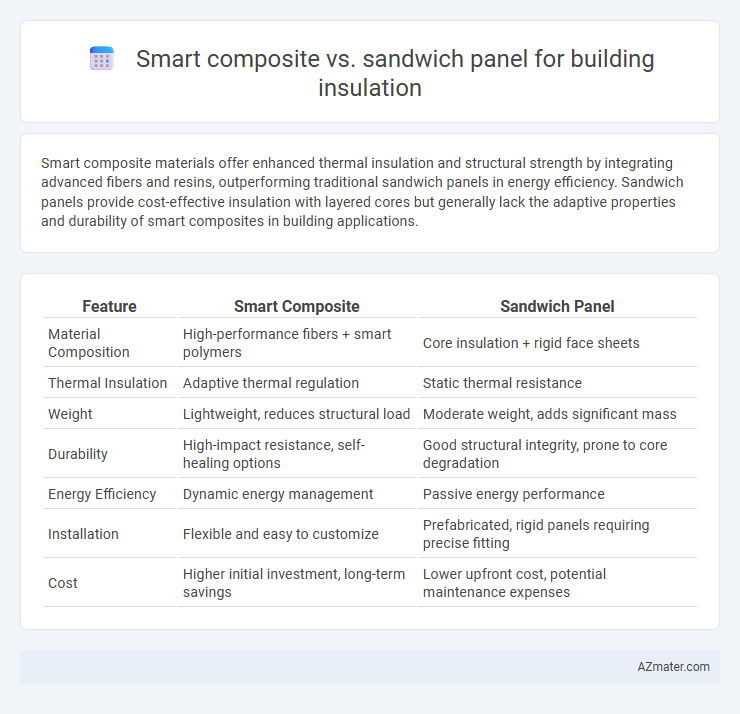Smart composite materials offer enhanced thermal insulation and structural strength by integrating advanced fibers and resins, outperforming traditional sandwich panels in energy efficiency. Sandwich panels provide cost-effective insulation with layered cores but generally lack the adaptive properties and durability of smart composites in building applications.
Table of Comparison
| Feature | Smart Composite | Sandwich Panel |
|---|---|---|
| Material Composition | High-performance fibers + smart polymers | Core insulation + rigid face sheets |
| Thermal Insulation | Adaptive thermal regulation | Static thermal resistance |
| Weight | Lightweight, reduces structural load | Moderate weight, adds significant mass |
| Durability | High-impact resistance, self-healing options | Good structural integrity, prone to core degradation |
| Energy Efficiency | Dynamic energy management | Passive energy performance |
| Installation | Flexible and easy to customize | Prefabricated, rigid panels requiring precise fitting |
| Cost | Higher initial investment, long-term savings | Lower upfront cost, potential maintenance expenses |
Introduction to Building Insulation Technologies
Smart composite insulation integrates advanced materials like aerogels and phase change materials to enhance thermal performance and energy efficiency in buildings. Sandwich panels consist of two structural facings bonded to a lightweight core, providing excellent thermal insulation, structural strength, and fire resistance. Both technologies are pivotal in modern building insulation strategies, improving energy conservation and occupant comfort.
What are Smart Composites?
Smart composites are advanced materials engineered with embedded sensors or actuators that respond to environmental changes, enhancing building insulation performance through adaptive thermal regulation. Unlike traditional sandwich panels, which consist of rigid insulation cores between structural facings, smart composites offer real-time monitoring and active control of heat flow, improving energy efficiency and durability in building envelopes. These innovative materials integrate nanotechnology and responsive polymers to optimize insulation properties based on temperature, humidity, or structural stress.
Overview of Sandwich Panels
Sandwich panels consist of two outer metal sheets bonded to a rigid core material like expanded polystyrene, polyurethane, or mineral wool, providing high thermal insulation and structural strength for building applications. These panels offer excellent fire resistance, durability, and energy efficiency, making them ideal for walls, roofs, and facades in commercial and industrial constructions. Their lightweight design simplifies installation while enhancing thermal performance compared to traditional building materials.
Thermal Performance Comparison
Smart composite panels offer superior thermal insulation due to their advanced multi-layer structures incorporating phase change materials and aerogels, which enhance heat retention and reduce energy loss more effectively than traditional sandwich panels. Sandwich panels typically consist of rigid foam cores like polyurethane or polystyrene between metal facings, providing good but less adaptive thermal resistance. Studies show smart composites can improve thermal performance by up to 30% compared to conventional sandwich panels, making them more efficient for energy-saving building insulation applications.
Energy Efficiency Impact
Smart composites offer superior energy efficiency in building insulation due to their enhanced thermal conductivity properties and adaptive insulation capabilities, which reduce heat transfer more effectively than traditional materials. Sandwich panels provide robust insulation with their multi-layered structure, combining rigid cores and protective facings to minimize thermal bridging and improve overall building envelope performance. Incorporating smart composites can result in significant energy savings by optimizing temperature regulation and reducing HVAC load compared to conventional sandwich panels.
Mechanical Strength and Durability
Smart composites exhibit superior mechanical strength due to their enhanced fiber-matrix bonding and tailored material properties, making them highly resistant to impact and fatigue in building insulation applications. Sandwich panels provide excellent durability through their layered structure, combining lightweight cores such as foam or honeycomb with rigid facings, which offer high stiffness and resistance to environmental degradation. Both materials improve building insulation performance, but smart composites deliver higher mechanical strength, while sandwich panels excel in long-term durability and thermal efficiency.
Moisture and Fire Resistance Capabilities
Smart composite panels excel in moisture resistance due to advanced hydrophobic coatings and closed-cell foam cores that prevent water infiltration and mold growth. Sandwich panels often utilize rigid insulation cores like EPS or PIR combined with metal facings, providing strong fire resistance and structural integrity under high temperatures. Comparative studies highlight smart composites as superior in moisture management, while sandwich panels typically lead in fire retardancy, making the choice dependent on specific building code requirements and environmental conditions.
Installation and Maintenance Considerations
Smart composite panels offer streamlined installation with lightweight materials that reduce labor time and require minimal specialized tools, enhancing efficiency on-site. Sandwich panels feature a rigid core between two metal facings, providing robust thermal insulation but often demanding precise alignment and fastening techniques to prevent thermal bridging and maintain structural integrity. Maintenance for smart composites generally involves less frequent inspections due to their high durability and resistance to environmental factors, whereas sandwich panels may require periodic checks for corrosion and joint sealant integrity to preserve insulation performance.
Cost Comparison: Smart Composite vs Sandwich Panel
Smart composite insulation typically incurs higher initial costs compared to sandwich panels due to advanced materials and fabrication techniques. Sandwich panels offer cost-effective solutions with lower material and installation expenses, making them popular in large-scale commercial and residential applications. Long-term energy savings and durability may offset smart composite upfront investment, influencing total cost of ownership.
Future Trends in Insulation Materials
Smart composites in building insulation integrate advanced sensors and adaptive materials that respond to environmental changes, enhancing energy efficiency and comfort. Sandwich panels, traditionally composed of rigid foam cores and metal facings, are evolving with eco-friendly cores and improved fire resistance to meet sustainability goals. Future trends emphasize hybrid materials combining smart composites with sandwich panel technology for optimized thermal performance and structural strength.

Infographic: Smart composite vs Sandwich panel for Building insulation
 azmater.com
azmater.com